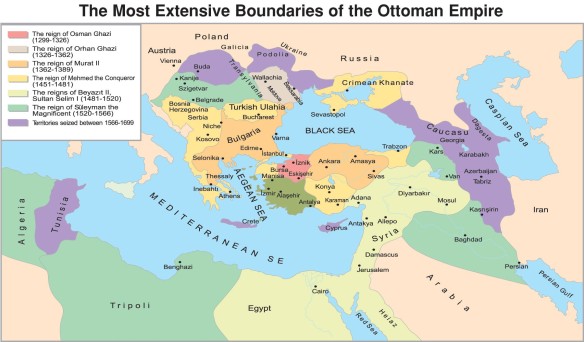For more than 600 years, the Ottoman Empire ruled large parts of south-eastern Europe, the Middle East, and east Africa. Founded in the late 1200s, the empire achieved its greatest size and strength during the Renaissance, when it extended well into eastern Europe. Its efforts to expand farther brought it into conflict with the Holy Roman Empire of the HABSBURG DYNASTY and with other European powers.
Historical Overview.
By the late 1400s the Ottoman Turks* had created a vast empire. In 1453 their ruler MEHMED II (1432–1481) used overwhelming force to conquer CONSTANTINOPLE, the capital of the Byzantine Empire*. Within 30 years the Ottoman Empire had taken over several states in eastern Europe, including Serbia, Bosnia, and Herzegovina. It also dominated the states of Montenegro and Albania, but they remained independent. Venice surrendered some of its outlying land to the empire in 1479. Under SÜLEYMAN I (ca. 1495–1566), the Ottomans hoped to advance even farther into Europe. But in their attempt to do so, they encountered the Holy Roman Empire ruled by CHARLES V.
The two empires first confronted one another in HUNGARY, where the Turks destroyed the armies of Hungarian king Louis II in 1526. The Ottomans then laid siege to Vienna in 1529. To end the siege and free the city, the Habsburg rulers had to recognize Ottoman rule over most of Hungary and parts of Romania. Ottoman conquest of other areas of eastern Europe and lands bordering the Black Sea followed.
The conflict between the Ottoman and Habsburg empires extended to the Mediterranean Sea, where the Turkish navy fought against the forces of Spain and Venice. These battles ended in the destruction of the Turkish fleet at the Battle of Lepanto (1571). Many scholars regard this defeat as the beginning of the decline of the Ottoman Empire.
The Ottoman State and Society.
Ottoman rule brought a long period of peace to the lands controlled by the empire. Although Ottoman rulers held almost absolute power, they governed efficiently and allowed the practice of different religions.
The Ottoman sultan acted as military chief, lawgiver, and religious leader. As the commander of the armed forces, the sultan led his armies in jihad, or holy war, against unbelievers. As lawgiver, he served as the head of legal and religious hierarchies that controlled almost every aspect of human conduct. The sultan exercised these extensive powers through a system of government established by Mehmed II in the late 1400s.
The basic law of the Ottoman Empire—the Kanoun Namé—established the state structure and regulated the social order. A central council assisted the sultan. He appointed all the council members, including the grand vizier, who was the chief minister of state and leader of armies in the field. High-ranking administrators called pashas ran the large cities. These officials served only at the sultan’s pleasure.
The Ottomans divided society into two main categories. The first distinguished Muslims from non-Muslims, while the second identified those connected with the state and its institutions—known as “professional Ottomans”—from the rest of the population. Most “professional Ottomans” came from a system of slavery in which Christian male children had to convert to Islam. These slaves served in the military, worked at the palace, or performed other tasks. Many became trusted government officials.
Under Ottoman rule religious groups could practice their faith freely. At a time when Jews suffered persecution throughout Europe, the Ottoman Empire welcomed them for their skills and for their contacts with the outside world.
Ottoman Impact on Europe.
The Ottoman Empire’s conquest of Constantinople and its control of the eastern Mediterranean undermined the dominant position of Venice and Genoa in regional trade. Merchants from these Italian cities were forced to look elsewhere for markets. The Ottoman expansion also increased Western fears of the Muslims and may have contributed to the Holy Roman Empire’s decision in 1555 to recognize the legal rights of Protestants. Needing the support of Protestants in fighting the Turks, the Habsburgs took steps to come to terms with the followers of Martin LUTHER.
Many Europeans ignored the Ottoman Empire’s advanced methods of government, its tolerance of ethnic and religious diversity, and its scientific and cultural achievements. Instead, they condemned the Ottoman conquests as brutal and viewed the Turks as a threat to Christian civilization. Others, such as Luther and Desiderius ERASMUS, saw the Turks as a sign of God’s anger toward Europe and urged repentance and reform. However, as the Renaissance progressed, the threat of the Ottoman Turks became of less concern to Europe.
